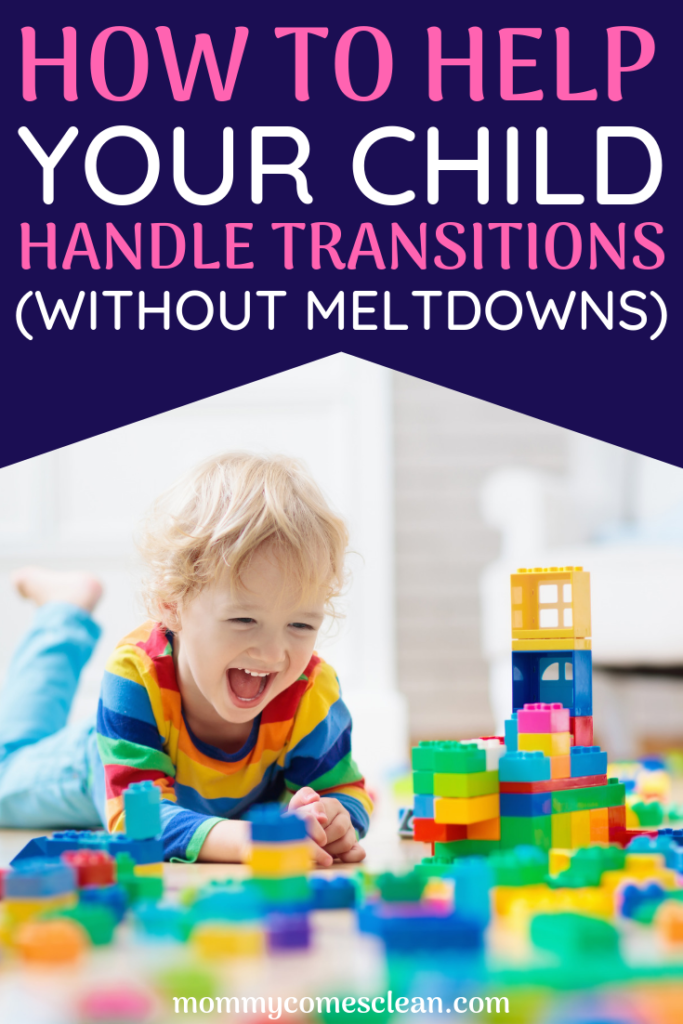Do your kids melt down when it comes time to quit an activity? My son is 3, and I’m extremely familiar with the agony of transitions for children. There’s yelling and crying and just overall misery for everyone involved.
I used to give him timed warnings–“five more minutes of play time and then we’re leaving!” Sometimes that worked, but many times the transition was still met with much wailing and gnashing of teeth.
Then I read an article about a more effective transition strategy for children. I had actually used a similar strategy from time to time in the past, but didn’t realize I was doing it.
After I read the article, I became more intentional about putting it into action. It’s been working really well for us.
Here’s why I try to avoid time-based warnings now, what we’re doing instead, and some examples of what it looks like in real life.
Why five-minute warnings don’t work
You’ve warned your child that he has only five more minutes to play. He knows it’s coming. So why does he still melt down when you tell him the time is up?
Children have a very incomplete sense of time. They develop an understanding of time from a young age, but they can only accurately judge the passing of time if they’re paying attention to it.
And the way they perceive time is very much context based. This article gives an interesting explanation of how children perceive time and how that perception changes as they get older.
When a child is distracted by an activity they enjoy, time becomes meaningless. So when you tell them only five more minutes, it probably feels more like 30 seconds.
Timers can help, especially if there’s a visual or auditory cue for the passing of time. We use timers sometimes for certain activities, but the concept is still a bit nebulous for a child.
Why “counting” transitions work better
While children may have a poor understanding of time, their understanding of counting is much more concrete.
Here’s how counting transitions work: instead of telling your child, “You have five more minutes to play,” give him a specific activity he can do a specific number of times.
For example, “I will give you 7 more pushes in the swing, and then we need to go home for lunch.”
That’s a very concrete activity with an unmistakable ending point. Your child can count by himself or you can count together. Either way, you both know when the activity is over.
How many times?
The number you choose will vary based on your child’s age and what the activity is, but 7 is generally a good number.
It feels like a lot to your child, so he won’t feel cheated. But it’s not so much that it should take an hour to complete.
I try to make it an odd number, since odd numbers are strangely more appealing to our human psyche. Then I base the number on how quickly I think it will take him to complete it and how quickly we need to move on.
What if my child doesn’t use up his “times”?
So far this has happened to us only once. I told my son he could squirt his water toy five more times before we left the pool. He did it twice and then gave me an impish grin and stopped.
It was like he was telling me, “If I don’t ever get to five then we won’t ever have to leave!”
I said, “OK, I see you’re not going to use up all your squirts. So we’ll just go now.”
He used up his “squirts” fast after I said that!
Your child won’t want to miss the opportunity to use up everything he’s “due.” If he sees he has to use them or lose them, he will use them.
Some examples of count-based transitions
You will have to get a little creative to use this strategy. It’s so much easier to just give a child five more minutes to do whatever he wants.
It’s harder to come up with a way to count the activity he’s currently doing.
So here are some ideas to help you get started.
- At the playground
- “seven more times down the slide”
- “seven more pushes on the swing”
- “dump sand out of your dump truck five more times”
- At the pool
- “seven more cannonballs”
- “swim three more laps”
- Playing outside
- “take three more loops around the cul-de-sac on your bike”
- “throw the ball seven more times with your friend”
- On the computer
- “watch one more video”
- “play one more level of that game”
- At the trampoline park
- “seven more jumps on the trampoline”
- Playing in the house
- “build three more towers with your blocks”
- “drive your race car around the track seven more times”
Take some time to think through the activities your child enjoys doing and think of counting transitions that would work in those situations.
Then let me know how it goes! I’d love to know how this transition strategy works for you.

Was this post helpful? Make sure you pin it!